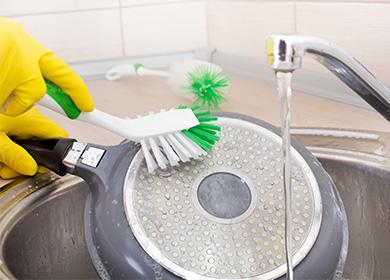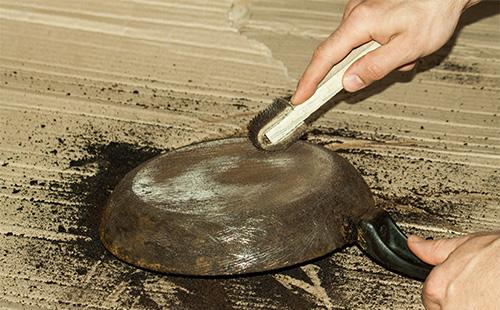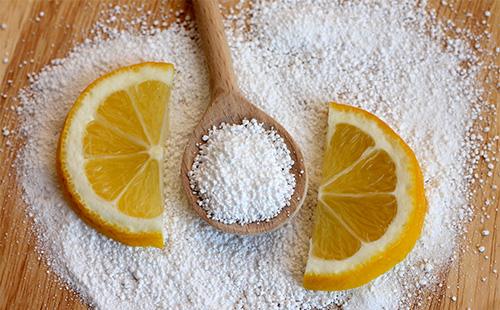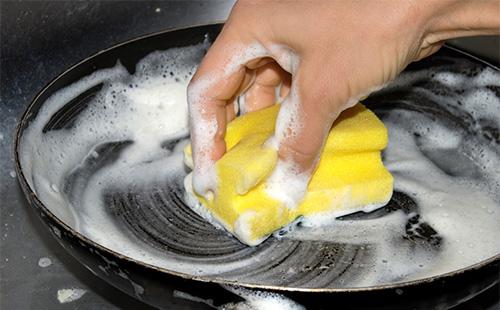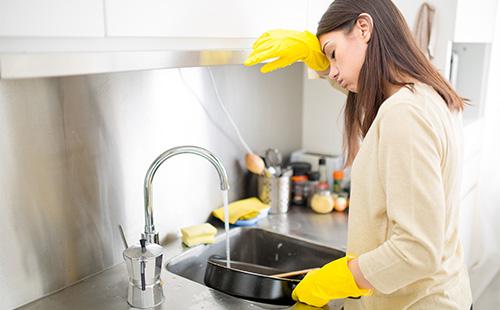The content of the article
Pans are diverse. They are different in functionality, in diameter, thickness and wall height. But the choice of means and methods of cleaning the product is directly related to the characteristics of the materials from which the dishes are made. Mostly pans are made from:
- cast iron;
- aluminum;
- of stainless steel.
Modern pans are easy to wash, they do not require a lot of oil, and food does not burn due to its high-tech coating:
- teflon;
- ceramic;
- enameled;
- marble.
Popular household chemicals
Modern frying pans will delight cleanliness for a long time, if after each use you immediately put them in order. In order to wash pans and pans from a thick layer of dirt, there are effective cleaners for this. Here are the trademarks that are heard:
- Fairy
- "AOS";
- "Gala";
- "Silite."
A few drops are enough to wash the non-stick pan from the inside, even from old fat. When working with store-based household cleaning products, there are four important rules:
- rinse thoroughly - many cleaning products do not wash off well;
- work with gloves - they will protect the skin of the hands from allergic reactions;
- provide airflow - you need to open the window or turn on the hood;
- put on a respirator - especially if you use "nuclear" cleaning agents.
How to quickly clean the pan: 2 "nuclear" means
Sometimes the soot on the dishes is so strong that ordinary detergents are simply powerless. Then the housewives turn to aggressive means for help. Some of them were not originally intended for dishes. The technology is unsafe and requires special care. Basically, two drugs are used to remove the stubborn layer of fat from the pan.
- Grease remover "Shumanit." The product is sold in the form of a cream, gel and liquid. It acts quickly and dissolves even burnt and perennial grease on surfaces. The peculiarity is that the drug works in literally minutes. But some housewives, in order to achieve impeccable cleanliness, leave the product longer. But here it is important to consider that “Shumanit” is toxic. Therefore, it is not suitable for continuous use and all manipulations must be carried out with gloves and a protective mask.
- Sewer Pipe Cleaning Fluid. The most aggressive but effective are chemical solutions for cleaning sewer pipes. Tools should be stored in a place protected from children.Any, even the oldest and thickest layer of soot will come off if you put the pan in a solution consisting of half a liter of such a product and five liters of water. Keep until you see that the dirt is completely behind. Prerequisite: pour the reagent into water, but not vice versa, otherwise you will not avoid an active chemical reaction.
To prevent carbon deposits: preventative care
In order for the pans to serve longer and to prevent the formation of old grease on the coating, follow the recommendations for care and maintenance. For different pans - their advice.
- Cast iron. It is better to warm it up before cooking. So it will burn less. Washing dishes will become easier, soot will be less.
- Aluminum In order not to have to look for a way to wash an aluminum pan from old fat, use the right detergent formulations during daily use. In this case, soda with warm water and a soft sponge work best. Abrasives are prohibited.
- Stainless. It is easy to clean the bottom of a stainless pan from scale and the remains of burnt food will help salt or soda. Spread half a glass of one or another substance on the bottom, lightly wet, leave for two to three hours. Stainless steel products also easily clean activated carbon. Grind ten tablets, mix with a few drops of water, treat problem areas, leave for half an hour. Rinse off the residue and brush lightly.
Cast Iron Pans
The food prepared in them is especially aromatic and delicious. Therefore, do not rush to throw away inherited dishes. It serves for a long time, is practical, and in many cases is indispensable. A big minus - the pans are heavy, quickly covered with old fat and soot, especially outside. It is possible to clean a cast-iron pan from long-term soot both by mechanical action, and with the help of folk remedies.
Remove plaque from the outside ...
Outside, cast-iron dishes are best cleaned mechanically, without chemicals. Occupation is laborious, therefore let the man be engaged in it. There are seven ways.
- Metal scraper. If the dishes are old and neglected, you will have to make a lot of effort. It is better to pre-heat it at high temperatures.
- Open fire. Before using the scraper, hold the pan over the open fire of the gas burner or place it in an oven heated to 250 ° C. The big minus is the smell of burning and chad. Open the window wide or do it outdoors. For example, over a bonfire on a garden plot. First remove the wooden handles or protect them from flame.
- Blowtorch. A man with this tool will easily clean even old dirt by simply directing the flame to the surface for five minutes. You need to do this on the street, cottage, in the garage.
- Sander. The nozzle should be an end flap. Carry out cleaning on the street, protecting yourself with a respirator, goggles, protective clothing.
- Electric drill. We need a nozzle, on the end of which a piece of sandpaper is attached. With some effort, you can clean the thickest layer of burnt fat, and then grind the pan with sandpaper to a shine.
- Sandblast. Such an installation is at a car repair station. Cleans with sand and compressed air. Auto mechanic quickly clean cooking utensils from dirt and rust. The disadvantage is that you can violate the integrity of cast iron.
- Sand. To remove carbon deposits, fill the pan to the top with sand and hold on low heat for at least three hours. Be sure to ventilate the room. If necessary, increase processing time. Then mechanically, in any convenient way, remove carbon deposits and rinse well with water.
... and inside
Recipes can be recalled from the old and proven methods, for example, cooking dishes where hydrogen peroxide, vinegar, laundry soap, salt, soda, lemon, clerical or silicate glue are used.
Silicate glue
- In a wide container made of metal, for example, in a basin or a tank for digesting clothes, pour 10 liters of water.
- Grate one bar of 72% laundry soap on a coarse grater or grind in any convenient way.
- Add 200 g of silicate glue and 0.5 kg of baking soda, mix, dissolve.
- Fully immerse dishes in a container.
- Open the window or window.
- Boil and keep on low heat for so long that the dirty layer softens. It will take from half an hour to five hours.
- Cool, remove, rinse thoroughly under running water.
- Use a wire brush if necessary.
- If the dirt remains - treat with “Shumanit” for half an hour, rinse well.
Citric acid
- Take two teaspoons of acid per liter of water.
- Boil the solution in a pan for 20 minutes.
- Cool, get it.
- Remove dirt residues with a metal brush.
Vinegar
- Mix water and vinegar in a ratio of 1: 3.
- Pour into a bowl, boil for five hours, adding water.
- Provide access to fresh air.
- Remove the smell of vinegar by cleaning the inside after boiling with baking soda.
Soda ash
- Pour to the bottom, distribute the salt evenly, pour half a glass of acetic acid.
- Leave for half an hour.
- Add five tablespoons of soda ash.
- Turn on the fire.
- Ignite for ten minutes.
- Rinse thoroughly under running fresh water.
Hydrogen peroxide
- Mix soda and hydrogen peroxide to make slurry.
- Heat the dishes.
- Lubricate the prepared mixture for ten minutes.
- Rinse thoroughly.
- If necessary, use a brush.
- If the result is unsatisfactory, repeat the procedure.
Vinegar and Citric Acid
- Pour two liters of water into a wide container.
- Dissolve half a glass of lemons and 200 g of vinegar.
- Bring the solution to a boil.
- Dip the pan completely.
- Keep on fire for 20 minutes.
- Remove, cool, pre-brush.
- Place again in the solution by adding four teaspoons of soda there.
- Keep on low heat for about 15 minutes.
- Cool, remove, clean the surface with a wire brush.
- If necessary, repeat the procedure until it shines.
Laundry soap
- Grate half the bar.
- Put on the bottom of the pan.
- To fill with water.
- Keep on fire for half an hour.
- Rinse under water.
Washing powder with vegetable oil
- Pour water into a wide basin.
- Add a handful of powder and a few tablespoons of oil.
- Place a pan in the basin.
- Bring to a boil, wait half an hour.
- Rinse thoroughly with water.
- It is better to take a hand wash powder to avoid heavy foaming.
Ammonia and brown
- Mix a glass of water, 10 g of borax and two drops of ammonia.
- Pour to the bottom of the pan.
- Wait half an hour, rinse with water.
We bring rust
Sometimes the dishes after rust removal remains rusty. What to do in this case? Remember that to solve the problem of rust is possible only after the complete removal of fatty deposits. To get rid of rust in a cast-iron skillet, follow these 12-step steps.
- Mix table vinegar with water in a ratio of 1: 8.
- Pour the solution into a wide and deep container.
- Immerse the utensils in a container with vinegar solution and leave for half an hour.
- Heat the oven to 130 ° C.
- Remove the pan from the container, remove any remaining rust, wash it with hot water and detergent, and dry it.
- Place in the oven upside down.
- Leave on for 30 minutes.
- Raise the temperature to 230 ° C and hold for about another hour.
- Turn off the oven and remove the pan.
- Once the pan has cooled, treat the inside and outside of the surface with a paper towel dipped in vegetable oil.
- Wipes are often changed, removing excess fat and achieving the desired shine.
- The last step is to place in a cooling oven, periodically removing and rubbing again until the oven cools down.
Restore the protective layer
So that the food does not burn, and the pan is washed well, you should warm it with ordinary salt. To do this, take the following six actions.
- Spread the salt evenly along the bottom.
- Warm up for half an hour.
- All this time stir the salt so that the bottom touches.
- Pour salt into a metal container, and after cooling - into a bin.
- Cool and rinse the pan.
- Good calcination again.
Aluminum pans
They are inexpensive, this is their only plus. They warm up quickly and unevenly, the food in them burns, especially oil. Metal releases compounds that are harmful to the body. It is difficult to clean, you can not use products containing acid and alkali, as well as metal scrapers.
Remove plaque from the outside ...
For complete cleansing use digestion or incandescent with sand. If you need to clean only the sides and the bottom from the outside, select the following recipes.
With silicate glue
- Mix silicate glue (half a cup), laundry soap (bar) and soda ash (half a cup).
- Dissolve in 10 l of water.
- Cook in a pan with a wide bottom until thoroughly cleaned.
- After rinsing, grate with a soft cloth.
With salt
- Prepare a solution: for 10 liters of water, 300 g of salt.
- Fully dip the dishes into the solution.
- Boil for at least two hours.
With sand
- Fill them to the utensils to the top.
- Glow, leave for two hours.
- Remove leftovers with a knife or tap.
- Rinse thoroughly with water and cleaning agent.
... and inside
Aluminum kitchen utensils were one of the very first to be used. During this time, a lot of effective and inexpensive cleaning methods have been invented. Try the following six.
- Baking soda. Process dishes with a soft sponge or boil with soda solution for half an hour.
- An Apple. If the inside is not very dirty, peel with half an apple.
- Dentifrice. Perfectly clean the aluminum coating inside. And if you heat the product, treat it with powder and leave it overnight, then in the morning, after washing and rinsing, the dishes will shine like new.
- Bow. A few onions, peeled and cut in half, need to be put to the bottom, pour water, boil for two hours over low heat.
- Table vinegar. He will remove the dark spots. Just treat the stains with this product.
- Detergent and water. To clean the pan from the smell of burning and vinegar will help the following technique: boil water in a pan and wash the dishes with detergent.
Operation tips
Daily gentle care and following simple rules will help keep your aluminum assistant in perfect cleanliness. Take on three more recommendations.
- Sandpaper. Do not clean the aluminum cookware with sandpaper. You ruin her appearance and harm her health. During processing, the metal is oxidized. Oxide, entering the body, destroys bone tissue.
- Washing powder. Do not use products containing alkalis, acids and chlorine. For example, washing powder. They will leave dark spots that will spoil the look.
- Dishwasher. Do not wash often in the dishwasher; the pan will become dull and dark.
Stainless Steel Pans
Such metal stores heat for a long time, so it is better to use it for cooking stews. From the advantages - stainless steel pans do not emit harmful substances, therefore they are safe, completely preserve the aroma and taste of the products, are not covered by rust, and are resistant to mechanical damage. But food often burns. Of the other drawbacks - in the process of operation, ugly spots are formed that cannot be washed with hard abrasive particles. Stainless steel is the most whimsical to care, not tolerating cleaning products in the form of powder and hard washcloths. Clean such dishes in the following ways.
Rock salt
- Spread the salt evenly across the bottom.
- Warm up for 15 minutes.
- Let stand a couple of hours.
- Sprinkle salt.
- Rinse with gel.
- Rinse with clean running water.
Baking or soda ash
- Wet the inside and outside with hot water.
- Pour plenty of soda.
- To rub especially dirty places with a porous sponge.
- Leave for half an hour.
- Rinse with hot water, rinse with cold.
- The procedure can be repeated.
Vinegar and Citric Acid
- Pour two cups of table vinegar into the pan, heat slightly.
- Open a window or turn on the hood.
- Pour a package of citric acid.
- Bring to a boil, turn off the heat.
- Hold under a closed lid for 30 minutes.
- Clean the remaining residues with a soft sponge.
- Rinse thoroughly.
Teflon coated
Teflon coating is applied to pans made of aluminum and stainless steel. The main advantages are resistance to high temperatures and aggressive environments during cleaning. An effective way to clean such a pan is a dishwasher. If there is no special equipment in the house, then a simple method of boiling with a detergent will help to clear the Teflon pan from long-term soot. You need to act in six steps.
- Pour water into the pan.
- Add a drop of detergent or a little soda ash.
- Bring to a boil, turn off the heat and wait about an hour.
- Pour out water, remove dirt with a soft microfiber cloth.
- Boil again with clean water.
- Pour out the water, wipe the dishes dry with a soft kitchen towel.
You can wash the non-stick pan from old fat from the inside in the same way, but replace the detergent with detergent, stationery glue or baking soda. And in order to clean the Teflon pan, including the pancake pan, from long-term soot not only inside but also outside, there are two more simple ways.
Coca-Cola Boiling
- Pour Coca-Cola into a large metal basin.
- Dip the pan into the drink.
- Put the container on fire and bring to a boil.
- Boil until the dishes are clean.
Soda ash boiling
- Prepare a solution of three liters of water, 50 ml of soda ash and a glass of any detergent.
- Pour the solution into a container with a wide bottom.
- Place the pan in a container.
- Boil for no more than half an hour.
- Then remove the dishes, rinse thoroughly, wipe with a soft cloth.
Marble coated
Marble pans have become popular. They are made of lightweight aluminum; marble chips are added to the non-stick coating for strength. During the formation of soot, marble products are cleaned like any other non-stick coating.
So that the surface remains intact for a long time, it should be thoroughly washed, dried, treated with vegetable oil before first use. It is not necessary to heat up.
These pans serve much longer compared to Teflon or ceramic, but subject to four simple operating rules.
- Do not abuse the dishwasher. It is allowed to wash in the device, but it is better not to part and do it manually.
- We use soda. To remove burnt food, pour a little water with soda, wait ten minutes, rinse the rest with water using a soft sponge.
- We protect from temperature changes. It is better to wash immediately after use, but allow to cool, protecting from temperature changes.
- Do not scratch. When cleaning, use a soft sponge or microfiber cloth.
Ceramic coated
Ceramic coating is applied to aluminum or cast iron products. Differs in high durability and safety. It warms up evenly, cools for a long time. The big minus is that it lasts relatively short. After a few months, the coating begins to deteriorate and loses its non-stick properties. To prolong the service life, before the first use, the product is recommended to be washed, dried, slightly wiped with vegetable oil, it is better olive. And after the first use of the ceramic pan, rinse it with a solution of salt and thoroughly wipe it with a kitchen towel. Subsequent cleaning with a soft cloth. Can be cleaned by any means. But he is afraid of temperature changes, so first you need to give the pan the opportunity to cool.
How can I clean a burnt ceramic pan? Try to just dunk for a start. If you feel that just soaking it will not help, then put the dishes on the fire, adding water and a little gel, so that the remaining food is steamed. Then they will be easy to remove. Take on five more ways.
- Alcohol. You can easily cope with old spots with ordinary alcohol. Moisten a cotton wool with them, wipe the surface. Repeat the procedure several times if necessary.
- Oven cleaner. If soot spoils the appearance, feel free to use an oven cleaner, which should not contain citric acid and bleach. Work the dishes outside, leave for a while. Then remove the dirt with a melamine sponge, which should never be used to clean the inside.
- Baking soda. Mix it with water until gruel forms, gently wipe the surface.
- Mustard. After adding water to the powder, make a slurry that perfectly copes with burned fat inside and out.
- Borax and ammonia. For 200 ml of water, add a few tablespoons of borax, three drops of ammonia. Fill the pan with a solution, leave for an hour. Rinse with a soft cloth, rinse with clean water.
Enamelled
It has entered the market again and is returning to its former popularity. But now with improved non-stick characteristics. One minus - the coating easily breaks off during impacts. The rest is just a plus: the products in such pans are not oxidized, therefore they are safe for health. The dishes are easy to clean, a thick layer of enamel protects from scratching. Enamel warms up for a long time, gives off heat for a long time. It is mainly covered with cast iron products. It is better to use such cookware for stewing. Cleaning products - citric acid, soda, vinegar.
There are many ways to clean the pan at home. Basically, they are cheap and easy to implement. But it is better if you monitor the cleanliness of dishes daily and fight with the remnants of fat and soot immediately after use. So you will save the health of your family members and the pan.
